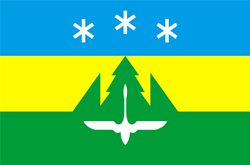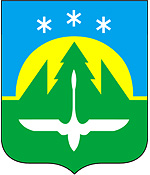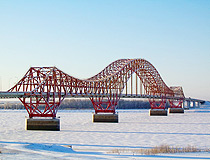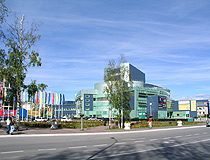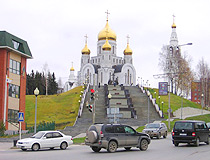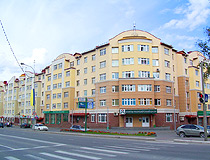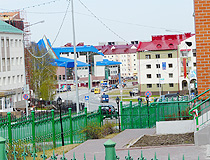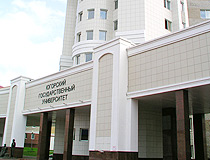History of Khanty-Mansiysk
Khanty-Mansiysk in the 16th-18th centuries
In May 1582, the Cossacks began a “yasak campaign” (to exact fur tribute from the indigenous peoples of Siberia) along the Ob and Irtysh rivers, and didn’t meet any serious resistance on their way until Samar, the chief prince of the local Khanty (Ostyaks) people, decided to fight back and was killed. The settlement that existed in this territory was plundered and deserted. The full inclusion of Siberia in Russia took another half a century.
In the 1630s, people from other parts of Russia began to arrive in the lower Irtysh to service the postal tracts. In 1635, one of the first official documents was signed on the creation of Samarovsky settlement, which was named after the Khanty Prince of Samar killed here.
In the 17th century, its favorable location at the intersection of important routes allowed Samarovskaya sloboda (settlement) to become a center of trade. Merchants from all over the world brought cloth, velvet, silk, spices, jewelry to Siberia. Russian merchants offered fur, fish, hides, dishes, buttons, gunpowder. A branch of the Tobolsk Customs was opened here, where screening and evaluation of goods were carried out, duties were collected.
In 1708, Samarovo became part of the Siberian Governorate. In the 18th century, the residents of the settlement had to master crafts and production, since Eastern Siberia was joined to Russia and the main trade routes shifted south. The settlement began to be called Samarovo. In 1748, the population of the village was 487 people.
More Historical Facts…
Khanty-Mansiysk in the 19th-20th centuries
In the 19th century, Samarovo began to attract more and more attention from travelers, researchers, and scientists. Edmond Cotteau, a French traveler, wrote: “Samarovo is a beautiful settlement built at the foot of hills covered with dense forest. The church with white domes stands in the middle of it. Previously, the capital of the Ostyak kingdom stood here, but its original residents left it and settled in remote valleys. Now, the only residents here are Russians…”.
At the turn of the 19th-20th centuries, Samarovo became a prosperous village with numerous large two-story houses. In 1930, a decree was issued on the organization of the Ostyak-Vogul National District. In 1931, 5 km from Samarovo, construction of the new capital of the region began. It was named Ostyako-Vogulsk. In 1937, a road was built between the new village and Samarovo. Later, it began to be called “Khanty-Mansiysk Street”. In 1938, the population of Ostyako-Vogulsk was about 7.5 thousand people. In 1940, Ostyako-Vogulsk was renamed Khanty-Mansiysk.
In 1950, the village of Khanty-Mansiysk received the status of a town, the village of Samarovo became its part. In 1953, a natural gas field was discovered in the village of Berezovo located north of Khanty-Mansiysk. In 1960, oil was discovered in the Khanty-Mansi Autonomous Okrug. Khanty-Mansiysk began to grow and develop rapidly.
The airport was reconstructed, new apartment buildings, schools, kindergartens, libraries, and a cultural center were built. Thousands of people arrived to develop the oil region. In 1989, the population of Khanty-Mansiysk was about 34.5 thousand people.
The latest history of Khanty-Mansiysk
The beginning of the 1990s was a time of great changes for Khanty-Mansiysk. In 1993, the Khanty-Mansiysk Autonomous Okrug became a subject of the Russian Federation and received the right to independently form its own budget.
Significant funds began to be allocated for the development of the transport and communal infrastructure of the region, for the implementation of social programs aimed at improving the living conditions of the population, preserving the traditional culture of the indigenous peoples of the North.
In 1993, the IV International Folklore Festival of Finno-Ugric Peoples was held in Khanty-Mansiysk. In 1996, a federal highway connected the city with Surgut, Nefteyugansk, and Tyumen.
In 2004, a unique automobile bridge was built over the Irtysh River and the city received reliable communication with Nyagan and other cities of the western part of the Khanty-Mansi Autonomous Okrug - Yugra. In 2010, the road built through the village of Gornopravdinsk reduced the distance from Khanty-Mansiysk to Tyumen by 300 kilometers.
In the 2000s, the city as the center of the largest Russian oil and gas region developed rapidly, its population more than tripled. A number of educational and scientific centers, cultural and sports facilities were opened in Khanty-Mansiysk: the Khvoyny Urman ski complex, the Ice Sports Palace, the Ugra-Athletics open stadium for 10,000 spectators, the Center for the Development of Tennis Sports, the cultural tourist complex “Archeopark”, the equestrian club “Mustang”, Yugra Chess Academy, and others.
In June 2008, Khanty-Mansiysk hosted the World Congress of Finno-Ugric Peoples and the V International Festival of Finno-Ugric Peoples Crafts “Yugra-2008”. In September 2010, the 39th World Chess Olympiad was held in Khanty-Mansiysk. About 1.5 thousand chess players from 158 countries arrived here to participate in the most massive sporting event in the history of the city.
Pictures of Khanty-Mansiysk
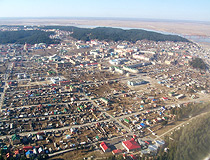
General view of Khanty-Mansiysk
Author: Sergov
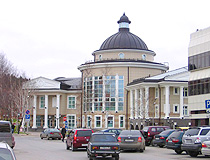
State Art Museum in Khanty-Mansiysk
Author: Igor Timoshok
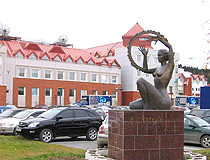
Sculpture of a woman with a tambourine in Khanty-Mansiysk
Author: Igor Timoshok
Khanty-Mansiysk - Features
Khanty-Mansiysk is located on the territory of the West Siberian Plain in the central part of Western Siberia, on the right bank of the Irtysh River, about 20 kilometers from the confluence with the Ob River; in the natural zone of the taiga. The distance to Tyumen is 669 km, to Moscow - about 2,580 km.
It is the largest of the centers of the autonomous regions of Russia and the only one with a population of more than 100,000 people. At the same time, it is one of the few Russian administrative centers, which is smaller than other cities of the region. Khanty-Mansiysk is only the fourth largest city of the Khanty-Mansi Autonomous Okrug after Surgut, Nizhnevartovsk, Nefteyugansk.
This city is equated to regions of the Far North and is located in the continental climate zone. The average temperature in January is minus 18.9 degrees Celsius, in July - plus 18.4 degrees Celsius.
In recent years, Khanty-Mansiysk has one of the highest, even by all-Russian standards, population growth rates. The annual growth is about three thousand people. Students and working youth make up more than 30% of its population. The average age of a city resident is about 35 years.
Khanty-Mansiysk is a green city. Almost a third of its territory is occupied by forest. The city is surrounded by Samarovsky Chugas Park - a natural reserve with relict species of conifers. The environmental situation in the city is very favorable, because there are no large industrial enterprises.
The airport of Khanty-Mansiysk offers regular flights to Moscow, Kazan, Novosibirsk, Yekaterinburg, Krasnoyarsk, Ufa. It is connected by road with other major cities of the Tyumen region (Surgut, Nefteyugansk, Tyumen).
Passenger ships connect Khanty-Mansiysk with a lot of towns and villages of the region, as well as with Tobolsk, Omsk, and Salekhard. The nearest railway stations are Pyt-Yakh (248 km from Khanty-Mansiysk) and Demyanka (238 km from Khanty-Mansiysk). The bus network of Khanty-Mansiysk is represented by 7 city and 1 country bus routes.
Khanty-Mansiysk is a center of skiing of world importance. Here, from the beginning of the 2000s, a modern biathlon center has been operating. In 2000, 2005, and from 2007 to 2016 (except for 2014), the stages of the Biathlon World Cup were held here.
The most interesting souvenirs you can bring from Khanty-Mansiysk are various leather and fur products, original Khanty tambourines, folk dolls and Khanty toys, beadwork, pine nuts, wicker products made from cedar roots and grass.
Main Attractions of Khanty-Mansiysk
Archeopark “Samarovsky Ostanets” - a cultural and tourist complex with sculptures of ancient animals and people. The main sight is the famous stone sculpture of 11 mammoths. In addition, there are sculptures of wolves and bison, lions, deer, bears, rhinos, and other animals from the Pleistocene. Obyezdnaya Street, 23.
Museum of Nature and Man - one of the oldest and most interesting museums in Khanty-Mansiysk. The collection of this museum numbers more than 120 thousand exhibits: various cultural and everyday objects of the Khanty and Mansi peoples, reconstructions and models of ancient buildings, skeletons and stuffed animals, expositions showing external and internal processes of the Earth. Mira Street, 11.
State Art Museum. The art collection of this museum consists of sections of icon painting, Russian painting, graphics, prints, arts and crafts, and sculpture. Here you can see the paintings of famous masters of Russian fine art: Rokotov, Tropinin, Repin, Aivazovsky, Surikov, Levitan, and other artists of the 18th-20th centuries. The section of old Russian art includes works of icon painting of the 15th-19th centuries. Mira Street, 2.
Museum of Geology, Oil and Natural Gas. Khanty-Mansiysk is considered the heart of the natural gas and oil industry in Russia. The largest oil and gas fields in the country are located in this region. The collection is based on historical documents and photographs, precious stones, minerals and rocks, samples of oil production equipment, and decorative items. Chekhova Street, 9.
House-Museum of the People’s Artist of the USSR Vladimir Igoshev. The purpose of the museum is to popularize the works of the artist, who depicted in his paintings the beauty of the Siberian land, its history and culture, and the people living in Yugra. In addition to the exhibition halls, you can also visit the artist’s workshop and apartment. The appearance of the building constructed in the Russian Art Nouveau style with mosaics and stucco moldings is also interesting. Lopareva Street, 7.
Ethnographic open-air museum “Torum-Maa”. Located in the picturesque forest of the Siberian taiga, this museum preserves the culture and traditions of the Khanty and Mansi peoples. Here you can see the constructions of the indigenous inhabitants of this land, their household items, clothes, jewelry, and various collections of old objects. Traditional festivals and ceremonies are also held here. The name of the museum means “Holy Land”. Sobyanina Street, 1.
Orthodox complex “In the Name of the Resurrection of Christ”. Its majestic buildings, crowned with gilded domes, can be seen from almost any part of Khanty-Mansiysk. Built in 2005, the complex includes more than 10 buildings, the main of which are the Cathedral of the Resurrection, an Orthodox gymnasium and a school, the Church of Prince Vladimir, and a 62-meter bell tower, which is one of the tallest buildings in the city.
Here you can also find the first in Russia Orthodox park of Slavic writing and culture “Slavic Square” decorated with sculptures on the theme of the Ten Commandments. In addition, the complex has monuments to saints, alleys, playgrounds, and places for recreation. Gagarina Street, 9.
Monument to the Discoverers of the Yugra Land - a picturesque 62-meter trihedral pyramid lined with glass. Each side symbolizes an important milestone in the history of Yugra - the appearance of indigenious peoples, the exploration of the region by the Cossacks of Ermak, and the discovery of oil and natural gas fields. The pyramid is visible from anywhere in Khanty-Mansiysk as it is located on the slope of a high hill surrounded by forest. Pervootkryvateley Lane, 1.
The Red Dragon Bridge over the Irtysh River - one of the most beautiful bridges not only in Western Siberia, but also in Russia. The 1,316-meter-long bridge was built in 2004. It connects Khanty-Mansiysk with the western part of the Khanty-Mansi Autonomous Okrug.
Samarovsky Chugas Nature Park - a great place for ecotourism lovers. Spread along the picturesque hills, Samarovsky Chugas covers an area of ??more than 6.5 thousand hectares with dense forests, streams, and blue lakes. This park, once called the Khanty-Mansiysk Hills, has the status of a natural monument. This is a favorite place for lovers of wildlife and walks in the fresh air. The visitors of the park are also offered ecological sightseeing routes with an experienced tour guide.


